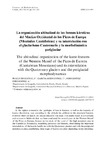Mostrar o rexistro simple do ítem
La organización altitudinal de las formas kársticas del Macizo Occidental de los Picos de Europa (Montañas Cantábricas) y su interrelación con el glaciarismo Cuaternario y la morfodinámica periglaciar
| dc.contributor.author | Ruiz-Fernández, Jesús | |
| dc.contributor.author | García-Hernández, Cristina | |
| dc.contributor.author | Fernández Fernández, Antonio | |
| dc.date.accessioned | 2020-01-23T08:47:15Z | |
| dc.date.available | 2020-01-23T08:47:15Z | |
| dc.date.issued | 2019 | |
| dc.identifier.citation | Cadernos do Laboratorio Xeolóxico de Laxe: Revista de xeoloxía galega e do hercínico peninsular, ISSN 0213-4497, Nº 41, 2019, páxs. 153-200 | es_ES |
| dc.identifier.issn | 0213-4497 | |
| dc.identifier.uri | http://hdl.handle.net/2183/24751 | |
| dc.description.abstract | [Resumen] En los conjuntos montañosos con un desarrollo altitudinal importante, la tipología de las formas kársticas presentes, así como la intensidad de la disolución kárstica, varían en función de la altitud (además de los consabidos factores estructurales). Sin embargo, apenas existen estudios relativos a esta cuestión. Este trabajo, basado fundamentalmente en la realización de un trabajo de campo sistemático y exhaustivo que se ha prolongado durante varios años en el Macizo Occidental de los Picos de Europa, se centra en el estudio del modelado kárstico de este macizo cantábrico de alta montaña. En él se han identificado los procesos y formas presentes, determinando las interrelaciones del relieve kárstico con el glaciarismo cuaternario y con la morfodinámica periglaciar, estableciendo tres fases de evolución kárstica en función de la sucesión de distintas condiciones morfoclimáticas y de la consiguiente actuación de diversos agentes morfogenéticos (karst preglaciar, glaciar y postglaciar) y definiendo cuatro franjas kársticas a tenor del gradiente altitudinal: área de karst cubierto oceánico de media montaña, sector de los frentes glaciares y las cubetas glaciokársticas bajas, desierto kárstico, y área de karst nival de alta montaña | es_ES |
| dc.description.abstract | [Abstract] In the highest mountains, the typologies of karstic features, as well as the intensity of karstic dissolution, vary according to the altitude (in addition to the structural factors). However, there are hardly any studies related to this issue. This paper, based in a systematic and exhaustive fieldwork that has been conducted for several years in the Western Massif of the Picos de Europa, focuses on the study of the karst of this high mountain area in the Cantabrian Mountains, examining processes and features, determining the important interrelations of the karstic landforms with the Quaternary glaciers and with the periglacial morphodynamics, establishing three stages of karstic evolution depending on morphoclimatic conditions (preglacial karst, glacial karst, and postglacial karst) and differentiating four karstic belts according to the altitudinal gradient: mid-mountain covered oceanic karst area, sector of glacial fronts and low glaciokarst depressions, karstic desert, and nival karst area of high mountain. | es_ES |
| dc.language.iso | spa | es_ES |
| dc.relation.uri | https://doi.org/10.17979/cadlaxe.2019.41.1.58221 | es_ES |
| dc.subject | Evolución kárstica | es_ES |
| dc.subject | Franjas kársticas | es_ES |
| dc.subject | Glaciokarst | es_ES |
| dc.subject | Morfodinámica periglaciar | es_ES |
| dc.subject | Picos de Europa | es_ES |
| dc.subject | Karstic evolution | es_ES |
| dc.subject | Karstic belts | es_ES |
| dc.subject | Glaciokarst | es_ES |
| dc.subject | Periglacial morphodynamics | es_ES |
| dc.title | La organización altitudinal de las formas kársticas del Macizo Occidental de los Picos de Europa (Montañas Cantábricas) y su interrelación con el glaciarismo Cuaternario y la morfodinámica periglaciar | es_ES |
| dc.title.alternative | The altitudinal organization of the karst features of the Western Massif of the Picos de Europa (Cantabrian Mountains) and its interrelation with the Quaternary glaciers and the periglacial morphodynamics | es_ES |
| dc.type | journal article | es_ES |
| dc.rights.accessRights | open access | es_ES |
| UDC.volume | 41 | es_ES |
| UDC.startPage | 153 | es_ES |
| UDC.endPage | 200 | es_ES |






